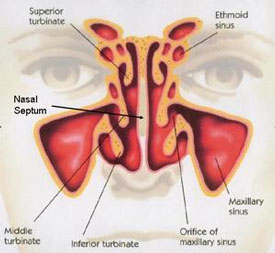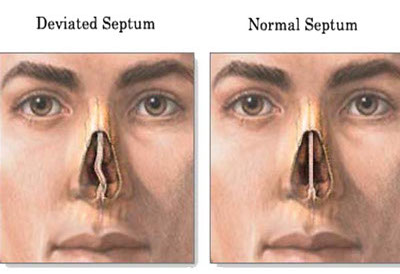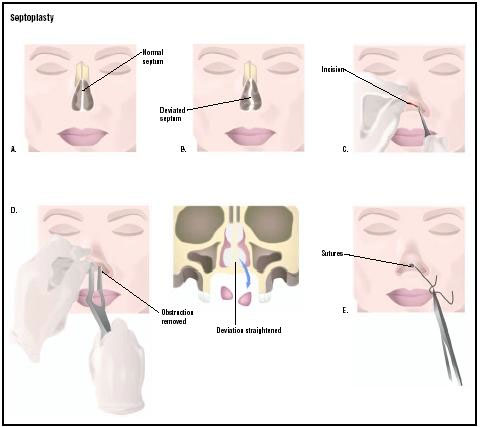Deviated Nasal Septum
The nasal septum is the wall dividing the nasal cavity into halves; it is composed of a central supporting skeleton covered on each side by mucous membrane. The front portion of this natural partition is a firm but bendable structure made mostly of cartilage and is covered by skin that has a substantial supply of blood vessels. The ideal nasal septum is exactly midline, separating the left and right sides of the nose into passageways of equal size.
80% of patients have a nasal septum that is off-center. In many patients this condition is generally not noticed due to the lack of any symptoms.
Septal deformities (deviations) are often a result of asymmetric growth of different parts of the nasal septum, or may be secondary to an injury (nasal trauma). A clinically significant “deviated septum” occurs when the septum is shifted away from the midline to such an extent that it causes symptoms and impaired functioning. The most common symptom from a deviated or crooked septum is difficulty breathing through the nose. The symptoms are usually worse on one side, but may also occur on the side opposite the bend. In some cases the deviated septum can interfere with the drainage of the sinuses, resulting in chronic and recurring sinus infections.


A deviated septum may cause one or more of the following symptoms:
- Nasal obstruction
- Frequent nosebleeds
- Frequent sinus infections
- Facial pain, headaches, and postnasal drip
- Snoring
Diagnosis
The board-certified surgeons at New England ENT have considerable experience in the evaluation and management of deviated nasal septum. Evaluation involves taking a thorough history including associated and pre-existing conditions such as allergy, sinus problems and history of nasal trauma. Examination of the nose is performed to assess the general appearance of the nose as well as the position and shape of the nasal septum. The exam may involve the use of a fiberoptic telescope, which is passed into the nose to fully assess the nasal passages for possible coexisting conditions such as enlarged turbinates, nasal masses/polyps and enlarged adenoids.
Septoplasty
Septoplasty is the preferred surgical treatment to correct a deviated septum. This procedure is not generally performed on minors, because the cartilaginous septum grows until around age 18. The surgery is an outpatient procedure performed entirely through the nostrils, without causing external bruising or changes in the external appearance of the nose. During the surgery, the deviated portions of the septum may be removed entirely, or may be readjusted and reinserted into the nose. The surgery may be combined with other surgeries such as a rhinoplasty (in which case the external appearance of the nose is altered for cosmetic reasons) or sinus surgery.

